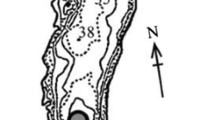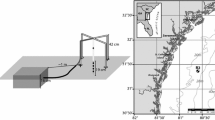Abstract
The transient and steady-state solution of the linear heat transfer equation considering the rate of compaction of sediments and the vertical migration of interstitial water are obtained, respectively, for a single layer and a multi-layer model of unconsolidated sediments. At steady state the temperature profile with depth becomes a convex curve rather than a straight line due to the presence of above factors. The time needed to reach the steady state is observed to be directly proportional to the square of the thickness of the layer. The thermal gradient at the surface increases parabolically with the increase in the rate of the above-mentioned factors.
The application of the steady-state results to the bore hole in Amchitka Island (Sass and Munroe, 1970) suggests that the observed surface heat flow value differs by 14% from the calculated one. Also the heat flow value at greater depth is calculated to be 2.02 · 106 cal cm 2s1, which is close to the mean value for Phillippine Trench (Nagasaka et al., 1970).
Similar content being viewed by others
References
BullardE. C.: 1939, ‘Heat Flow in South Africa’, Proc. Roy. Soc. London, A 173, 474–502.
BullardE. C., MaxwellA. E., and RevelleR.: 1956, ‘Heat Flow Through the Deep Sea Floor’, Adv. Geophys. 3, 153–181.
Lubimova, E. A., Von Herzen, R. P., and Udintsev, G. B.: 1965, ‘On Heat Transfer Through the Ocean Floor in Terrestrial Heat Flow’, Am. Geophys. Mon. 8, Washington, D.C., 78–86.
NagasakaK., FrancheteauJ., and KishiiT.: 1970, ‘Terrestrial Heat Flow in the Celebes and Sulu Seas’, Marine Geophys. Res. 1, 99–103.
NegiJ. G. and SinghR. N.: 1967, ‘On Heat Transfer in Layered Oceanic Sediments’, Earth Planetary Sci. Letters 2, 33–336.
SassJ. H. and MunroeR. J.: 1970, ‘Heat Flow from Deep Bore Holes on the Two Island Ares’, J. Geophys. Res. 75, 4387–4395.
SpiegelM. R.: 1965, Theory and Problems of Laplace Transformations, Schaum Publishing Co., New York.
Stallman, R. W.: 1960, ‘Notes on the Use of Temperature Data for Computing Groundwater Velocity’, Société Hydrotechnique de France, Naney, 6th Assembly on Hydraulics Rpt. 3, 1–7.
VonHerzenR. P. and UyedaS.: 1963, ‘Heat Flow Through East Pacific Ocean Floor’, J. Geophys. Res. 65, 1239–1249.
Author information
Authors and Affiliations
Rights and permissions
About this article
Cite this article
Panda, P.K. The transient and steady-state influence of sediment compaction and interstitial water expulsion on the temperature distribution in oceanic sediments. Mar Geophys Res 2, 37–49 (1973). https://doi.org/10.1007/BF00451869
Received:
Revised:
Issue Date:
DOI: https://doi.org/10.1007/BF00451869




